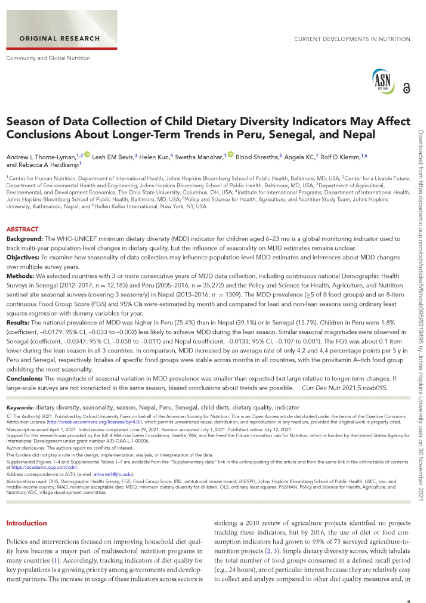Journal Article | https://pubmed.ncbi.nlm.nih.gov/34466772/
Date of Publication | July 2021
Abstract:
Background
The WHO-UNICEF minimum dietary diversity (MDD) indicator for children aged 6–23 mo is a global monitoring indicator used to track multi-year population-level changes in dietary quality, but the influence of seasonality on MDD estimates remains unclear.
Objectives
To examine how seasonality of data collection may influence population-level MDD estimates and inferences about MDD changes over multiple survey years.
Methods
We selected countries with 3 or more consecutive years of MDD data collection, including continuous national Demographic Health Surveys in Senegal (2012–2017; n = 12,183) and Peru (2005–2016; n = 35,272) and the Policy and Science for Health, Agriculture, and Nutrition sentinel site seasonal surveys (covering 3 seasons/y) in Nepal (2013–2016; n = 1309). The MDD prevalence (≥5 of 8 food groups) and an 8-item continuous Food Group Score (FGS) and 95% CIs were estimated by month and compared for lean and non-lean seasons using ordinary least squares regression with dummy variables for year.
Results
The national prevalence of MDD was higher in Peru (75.4%) than in Nepal (39.1%) or in Senegal (15.7%). Children in Peru were 1.8% (coefficient, –0.0179; 95% CI, –0.033 to –0.002) less likely to achieve MDD during the lean season. Similar seasonal magnitudes were observed in Senegal (coefficient, –0.0347; 95% CI, –0.058 to –0.011) and Nepal (coefficient, –0.0133; 95% CI, –0.107 to 0.081). The FGS was about 0.1 item lower during the lean season in all 3 countries. In comparison, MDD increased by an average rate of only 4.2 and 4.4 percentage points per 5 y in Peru and Senegal, respectively. Intakes of specific food groups were stable across months in all countries, with the provitamin A–rich food group exhibiting the most seasonality.
Conclusions
The magnitude of seasonal variation in MDD prevalence was smaller than expected but large relative to longer-term changes. If large-scale surveys are not conducted in the same season, biased conclusions about trends are possible
Suggested Citation:
Thorne-Lyman AT, Bevis LEM, Kuo H, Manohar S, Shrestha B, KC A, Klemm RD, Heidkamp RA. Season of Data Collection of Child Dietary Diversity Indicators May Affect Conclusions About Longer-Term Trends in Peru, Senegal, and Nepal. CDN. 2021; 5(8):nzab095.

